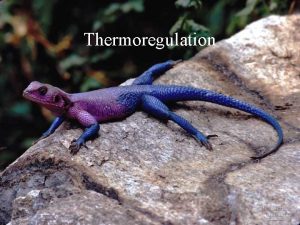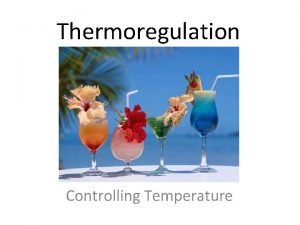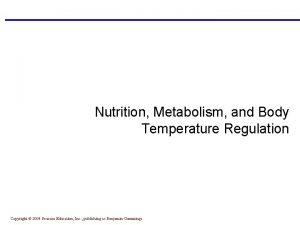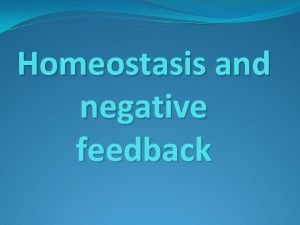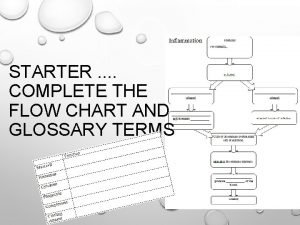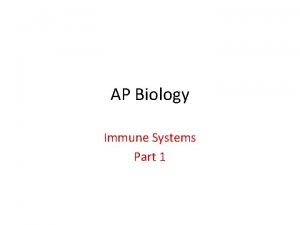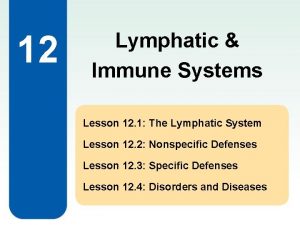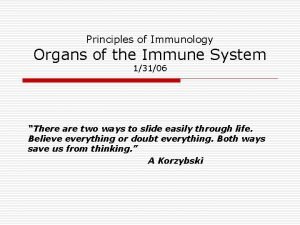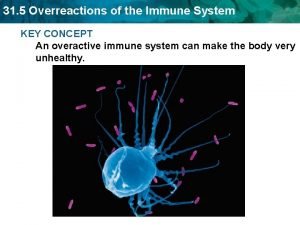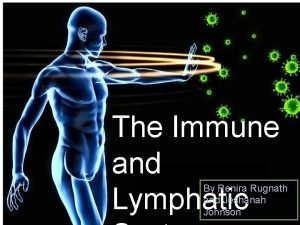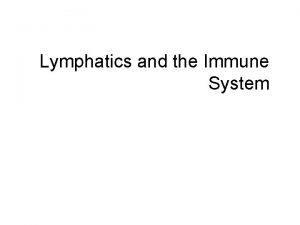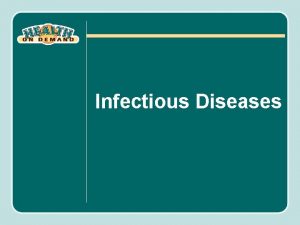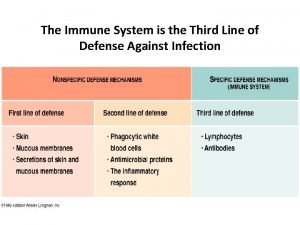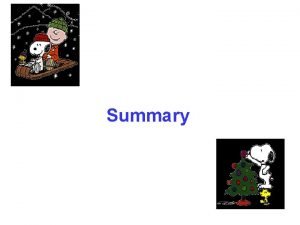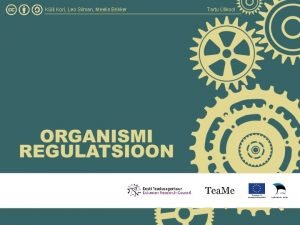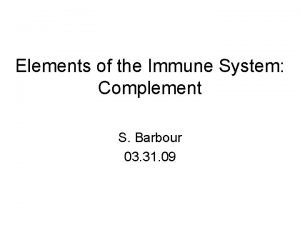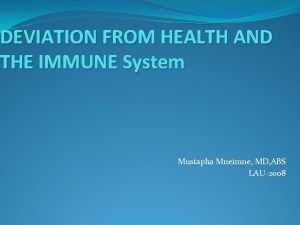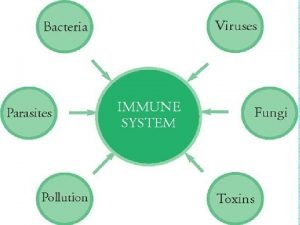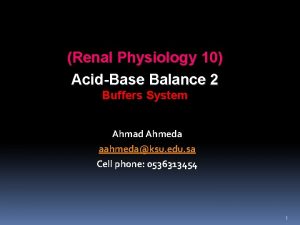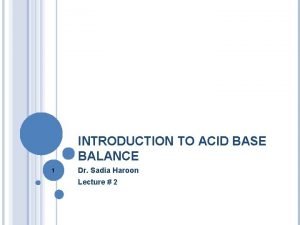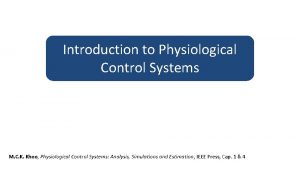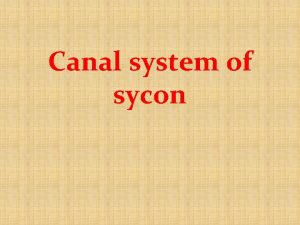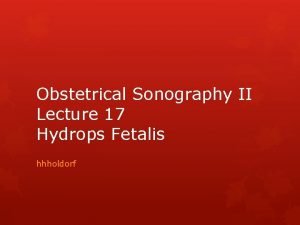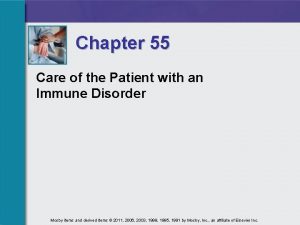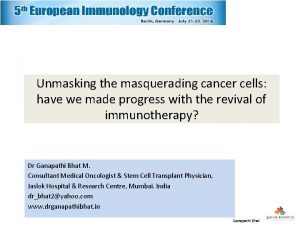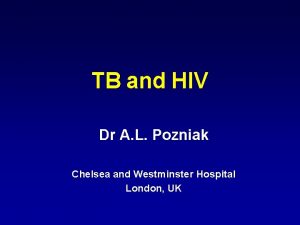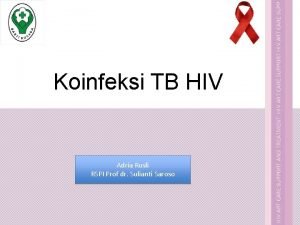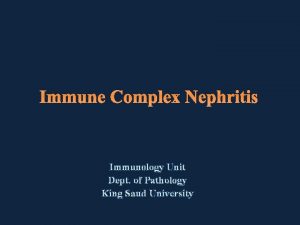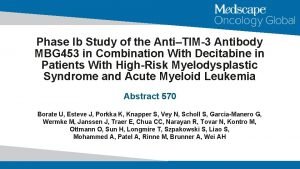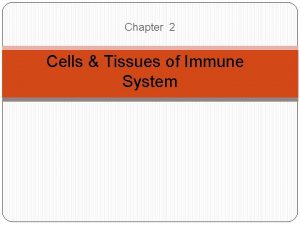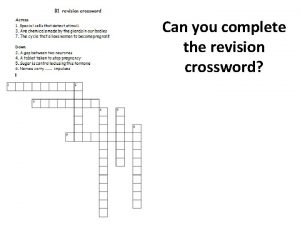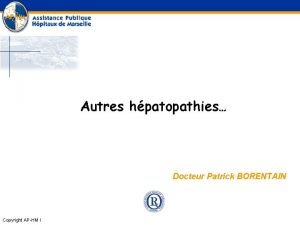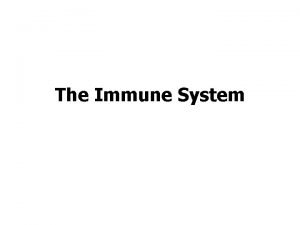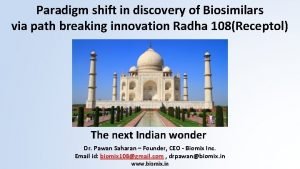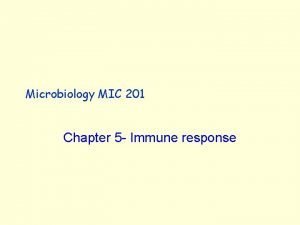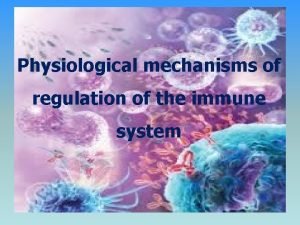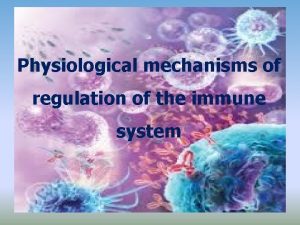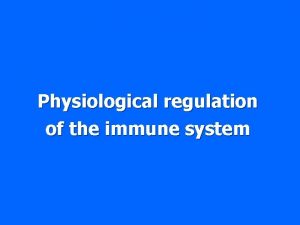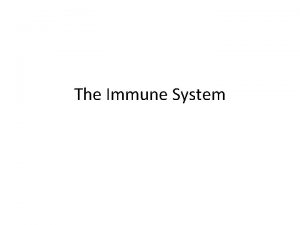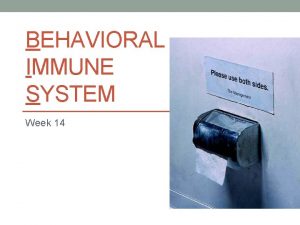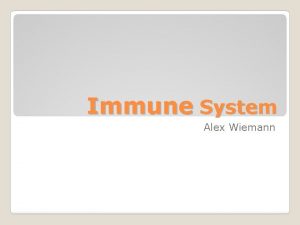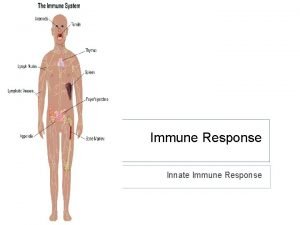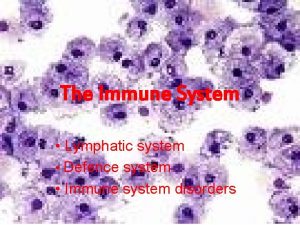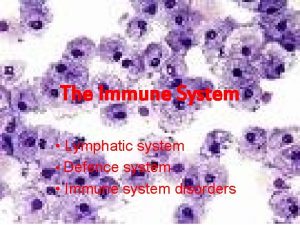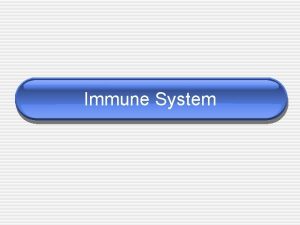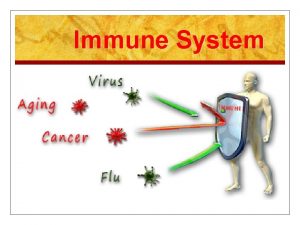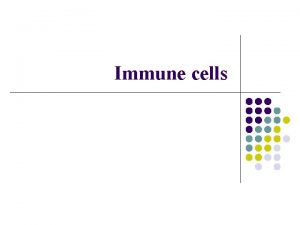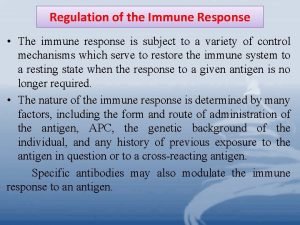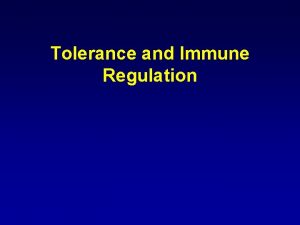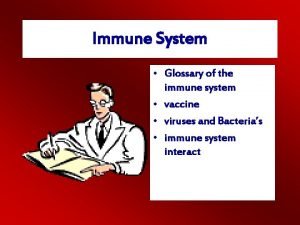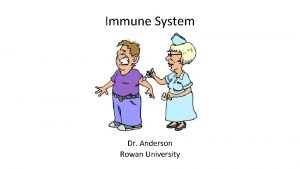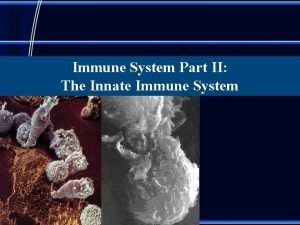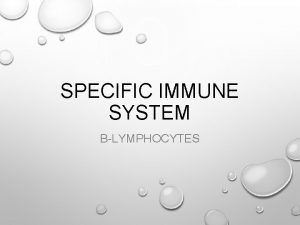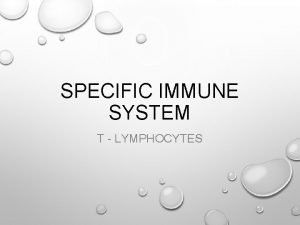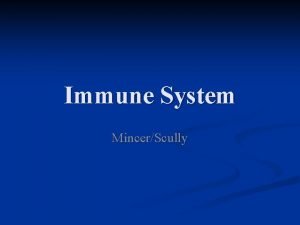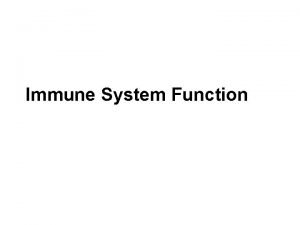Physiological mechanisms of regulation of the immune system


















































- Slides: 50

Physiological mechanisms of regulation of the immune system

Regulation by antigen Induce immune responses and extinction Affinity maturation of B lymphocytes Maintaining immunological memory Antigenic competition Threshold density of the complex MHC II-gp Ag on APC

Regulation by antibodies Antibodies competes with the BCR for antigen (negative regulator of B lymphocyte stimulating) Ig. G immune complexes bind to the BCR and Fc R on B cells, resulting in blocking activation of B lymphocytes Regulation via idiotypic network

Regulation by cytokines and cellular contact Interaction APC - T lymphocyte Interaction TH 1 – macrophages Interaction TH 2 - B lymphocytes Mutual regulation of activity TH 1 versus TH 2 Development of leukocyte subpopulations

Negative regulation of effector cells CTLA-4 - T cell inhibitory receptor, binds ligands CD 80 and CD 86 Self-destruction interaction of the apoptotic receptor Fas with ligand Fas. L on the surface of activated T cells nhibitory receptors of NK cells

Suppression mediated by T lymphocytes Clonal elimination or anergy of T lymphocytes after contact with antigen on the surface of other cells than APC Regulatory T cells (Treg, Tr 1, Th 3 - CD 4+) help to maintain tolerance to autoantigens; produce TGF , IL-10

Factors influencing the outcome of the immune response The same antigen can induce an active immune response or an active state of tolerance, the result of response depends on many factors: State of the immune system Properties of antigen Dose of antigen Route of antigen administration

Cytokines (Tissue hormones)

Cytokines Regulatory proteins and glycoproteins produced by leukocytes and other cells Are known as interleukins (IL-1…IL-38) (except: TNF, lymphotoxin, TGF, interferons, CSF and growth factors) Essential regulators of the immune system Apply also at angiogenesis, tissue regeneration, carcinogenesis, treatment of many brain functions, embryonic development. . .

Cytokines Effects of cytokines- autocrine - paracrine - endocrine Cytokines - secreted - membrane (CD 80, CD 86, CD 40 L, Fas. L. . )

Overview of the most important cytokines Cytokine Produced Function IL-1 MF, N T cell costimulation, induction of TNF and IL-8, pyrogen IL-2 Th 1 Growth factor for T cells IL-4 Th 2, basophils Th 2 differentiation, B cell stimulation, isotype switching to Ig. E and Ig. G 4, Th 1 inhibition IL-5 Th 2, eosinophils B cell stimulation, growth factor for eosinophils IL-6 Th 2, MF, N T and B cell stimulation, stimulation of Ig production, induction of acute phase proteins synthesis, pyrogen IL-8 MF, other cells Granulocyte activation and chemotaxis (primarily neutrophils) IL-10 Th 2, M, Treg Th 1 and MF inhibition, B cell differentiation to plasma cell IL-12 MF, DC, B Th 1 differentiation, NK stimulation TNF M, MF, NK Induction of local inflammation, endothelium activation, induction of apoptosis TGF T, MF, platelets The anti-inflammatory effect (control of lymphocyte proliferation, control of Ig production, control MF activity), stimulation of fibroblasts and osteoblasts, gain production of extracellular matrix IFN L, M, MF Inhibition of viral replication IFN Fibroblasts, epithelial cells Inhibition of viral replication IFN Th 1, NK MF activation, stimulation of MHC gp. expression, Th 2 inhibition MF – macrophages; M – monocytes; N – neutrophils; DC – dendritic cells; NK – natural killers; L – lymphocytes; B – B cell; T – T cell

Clasification of cytokines by functions 1. Proinflammatory cytokines (IL-1, IL-6, IL- 8, IL- 12, IL- 18, TNF) 2. Antiinflammatory cytokines (IL-4, IL-10, TGF ) 3. Cytokines with the activity of hematopoietic cells growth factor (IL-2, IL-3, IL-4, IL-5, IL-6, IL-7, IL-9, IL-11, IL-14, IL-15, CSF, SCF, LIF, EPO) 4. Cytokines applying in TH 2 humoral immunity (IL-4, 5, 9, 13) 5. Cytokines applying in the cell-mediated immunity TH 1 (IL-2, IL-12, IFN , GM-CSF, lymphotoxin) 6. Cytokines with anti-viral effect (IFN- , IFN- �, IFN- )

Cytokine receptors Consisting of 2 or 3 subunits One subunit binds cytokine, other are associated with cytoplasmic signaling molecules (protein kinases) Signaling subunit is shared by several different cytokine receptors - called receptor family Signaling through these receptors may lead to proliferation, differentiation, activation of effector mechanisms or blocking the cell cycle and induction of apoptosis

Possibilities of therapeutic affecting of the immune system

Substitution treatment autologous stem cell transplantation (following chemotherapy and radiotherapy) treatment with intravenous immunoglobulin (derived from plasma of blood donors) substitution of C 1 inhibitor for hereditary angioedema substitution of erythropoietin in patients with chronic renal failure substitution of G-CSF in agranulocytosis

Immunomodulation = medical procedure to adjust the disrupted immune function Non-specific immunosuppression nonspecific = affects not only autoreactive and aloreactive lymphocytes, but also other components of immunity (risk of reduction antiinfectious and antitumor immunity) used for treatment of autoimmune diseases, for organ transplantation and severe allergic conditions

Non-specific immunosuppression Corticosteroids • anti-inflammatory, immunosuppressive effects • suppress the expression of some genes (IL-2, IL-1, phospholipase A, MHC gp II, adhesion molecules) • inhibition of histamine release from basophils • higher concentrations induce apoptosis of lymfocytes

Non-specific immunosuppression Immunosuppressants affecting the metabolism of DNA (cytostatics) • cyclophosphamide (alkylating agent) • methotrexate (antimetabolite) • azathioprine (purine analogue)

Non-specific immunosuppression Immunosuppressant selectively inhibiting T cells • immunosuppressive ATB: cyclosporine A, tacrolimus, rapamycin (suppressing the expression of IL-2 and IL-2 R in activated T lymphocytes) • anti-CD 3 monoclonal antibody (imunosuppression after transplantation, treatment of rejection crises)

Anti-inflammatory and antiallergic treatment • nonsteroidal anti-inflammatory drugs • antihistamines - blocking H 1 receptor - reduce the expression of adhesion molecules - reduce the secretion of histamine. . . • inhibitors of inflammatory cytokine - monoclonal antibodies against TNF - thalidomide (TNF inhibitor) • Anti Ig. E antibodies (omalizumab) - severe allergic astma

Non-specific immunostimulant therapy synthetic immunomodulators Methisoprinol (Isoprinosine) - used in viral infections with more severe or relapsing course bacterial extracts and lysates Broncho-Vaxom - prevention of recurrent respiratory tract infections Ribomunyl products of the immune system IL-2 - renal adenocarcinoma IFN , IFN - viral hepatitis, some leukemia Erythropoietin – renal failure G-CSF, GM-CSF – neutropenia Transfer factor (blood donors leukocytes undergoing dialysis) Thymus hormones

Antigen-specific immunomodulation = induce of an immune response or tolerance to a specific antigen • active immunization • passive immunization • specific immunosuppression

Antigen-specific immunomodulation Active immunization (vaccination) = the induction of immunity after exposure to an antigen • activates specific cellular and humoral immunity • creates long-term immunity (memory cells) • protect against a pathogen bearing this antigen or similar antigen (prophylaxis)

Antigen-specific immunomodulation active immunization (vaccination) • vaccines are made from inactivated or attenuated microorganisms or their antigens (polysaccharide capsule, toxins) • attenuated vaccines cannot be used for immunocompromised individuals • risk of infection or anaphylactic reactions

Antigen-specific immunomodulation Passive immunization • natural - transfer of maternal antibodies in fetal blood • therapeutically - the use of animal antibodies against various toxins (snake toxins, tetanus toxin, botulinum toxin) • prophylaxis - the human immunoglobulin from immunized individuals (hepatitis A, rabies, tetanus) - Anti-Rh. D antibodies – prevent immunization of mother with Rh. D + fetus erythrocytes • provides a temporary (3 weeks) specific humoral immunity • the risk anaphylactic reactions

Antigen-specific immunomodulation Specific immunosuppression = induction of tolerance to a specific antigen • induction of tolerance by oral administration of antigen (treatment of certain autoimmune diseases) • allergen immunotherapy (pollen, insect poisons) Vaccination against cancer • immunization by dendritic cells

Antiinfection immunity

Defence against extracellular pathogens bacteria (gram-negative, gram-positive cocci, bacilli), unicellular parasites pathogens induce inflammation phagocytes are attracted to the site of infection by chemotactic substances (C 5 a, C 3 a and chemotactic products of bacteria, IL-8…) neutrophil granulocytes opsonization (C 3 b, Ig. G and Ig. A antibodies, lectins, CRP. . . )

Defence against extracellular pathogens Opsonisation and phagocytosis

Defence against extracellular pathogens ingested bacteria are destroyed by the microbicidal systems (products of NADP-H oxidase, hydrolytic enzymes and bactericidal substances in lysosomes) phagocytes produce proinflammatory cytokines (IL-1, IL-6, TNF)

Defence against extracellular pathogens Ig. M - complement activation Ig. G - complement activation, opsonization Ig. A - opsonization s. Ig. A prevents against infection by intestinal and respiratory bacteria in the defense against bacterial toxins apply neutralizing antibodies (Clostridium tetani and botulinum …)

Defence against extracellular pathogens "indirect toxins - bacterial Lipopolysaccharide (LPS) stimulates big number of monocytes to release TNF, which can cause septic shock individuals with immunodeficiency of phagocytes, complement and antibodies production are especially at risk of infections with extracellular bacterial

Defense against intracellular pathogens

Defense against intracellular pathogens bacteria, fungi and unicellular parasites intracellular parasites are resistant to the microbicidal mechanisms of phagocytes macrophages, which absorbed them, produce IL-12 → TH 1 differentiation, production of IFN and membrane TNF → activation of macrophages and production of NO

Defense against intracellular pathogens TC lymphocytes apply in the defense against intracelular parasites, which escape from phagolysosomes individuals with certain disorders of phagocytes and defects of T lymphocytes are at risk of infections with intracellular microorganisms

Defense against intracellular pathogens

Anti-viral defense

Anti-viral defence interferons - production of IFN and IFN is induced in infected cells; IFN activates macrophages (i. NOS) IFN and IFN prevents viral replication, induce proliferation of NK cells, increase the expression of HLA-I

Anti-viral defence NK cells ADCC (Antibody-dependent cell-mediated cytotoxicity); NK cell bind with CD 16 (Fc receptor) to Ig. G which has bound to the surface of infected cell and then NK cell release perforins and granzymes

Anti-viral defence antibodies are applied in the defense against cytopathic viruses: s. Ig. A inhibit mucosal adhesion of viruses (defense against respiratory viruses and enteroviruses) neutralizing Ig. G and Ig. M antibodies activate the classical pathway of complement, that is able to lyse certain viruses Ig. G and Ig. A opsonized viral particles are phagocytosed Ig. A and Ig. G have preventive effect in secondary viral infection

Anti-viral defence effector TC lymphocytes destroy infected cells in direct contact (granzym/perforin; Fas. L) and by produced cytokines (lymfotoxin) some viruses after infection integrate into the host genome, where persist for years (varicella zoster, EBV, papillomavirus) individuals with T lymphocyte immunodeficiency and with combined immune disorders are at risk by viral infections increased susceptibility to herpes infections in individuals with dysfunction of NK cells

Anti-viral defence – NK cells and Tc lymphocytes

Defense against protozoa parasites

Defense against protozoa parasites Toxoplasma gondii, Leishmania, Trypanosoma defense against protozoa parasites is similar to defense against bacteria extracellular parasites - antibodies intracellular parasites - TH 1 lymphocytes and activated macrophages

Defense against multicellular parasites

Defense against multicellular parasites Ig. E, mast cells, basophils and eosinophils TH 2 stimulation under the influence of IL-4 (mast cells and other APC stimulated by parasite) TH 2 stimulate B cells with BCR-specific parasite antigens isotype switching under the influence of IL-4 to Ig. E bind to Fc RI on mast cells and basophils

Defense against multicellular parasites multicellular parasite binds to Ig. E on mast cell→ crosslinking of several molecules Fc RI initiate mast cell degranulation (release of histamin, tryptase, serotonin…) activation of arachidonic acid metabolism (leukotriene C 4, prostaglandin PGD 2) - amplification of inflammatory responses cytokine production by mast cell (TNF, TGF , IL-4, 5, 6)

Defense against multicellular parasites Histamine vasodilatation, increase vascular permeability (erythema, edema, itching) bronchoconstriction (cough) increases intestinal peristalsis (diarrhea) increased mucus secretion This helps eliminate the parasite.

Defense against multicellular parasites - eosinophils

Defense against multicellular parasites eosinophils fagocyte complexes of parasitic particles with Ig. E via their receptors for Ig. E eosinophils use against parasites extracellular bactericidal substances released from granules (ECP- eosinophil cationic protein, MBP-major basic protein…) Thank you for your attention
 Primary immune response and secondary immune response
Primary immune response and secondary immune response Countercurrent exchange thermoregulation
Countercurrent exchange thermoregulation Negative feedback and body temperature regulation
Negative feedback and body temperature regulation Temperature regulation
Temperature regulation Negative and positive feedback mechanism of homeostasis
Negative and positive feedback mechanism of homeostasis What is the third line of defense in the immune system
What is the third line of defense in the immune system Immune system flow chart
Immune system flow chart Third line of defense immune system
Third line of defense immune system Second line of defense immune system
Second line of defense immune system Chapter 35 immune system and disease
Chapter 35 immune system and disease Primary vs secondary immune response
Primary vs secondary immune response Ap bio immune system
Ap bio immune system Lesson 12.1 lymphatic ducts and vessels
Lesson 12.1 lymphatic ducts and vessels Lesson 12 blood and immune system
Lesson 12 blood and immune system Oobean
Oobean Define immunity
Define immunity Overreactions of the immune system
Overreactions of the immune system Lymphatic vs immune system
Lymphatic vs immune system Phagocitize
Phagocitize Defination of infection
Defination of infection First line of defense
First line of defense What is the main function of the immune system
What is the main function of the immune system Malt tonsils
Malt tonsils Thymus immune system
Thymus immune system Mac immune system
Mac immune system Thalassemia facies
Thalassemia facies 1what's the purpose of the body's immune system?
1what's the purpose of the body's immune system? Physiological buffer system
Physiological buffer system Phosphate buffer system equation
Phosphate buffer system equation Hyppus
Hyppus Scypha canal system
Scypha canal system Hydrops fetalis
Hydrops fetalis Primary vs secondary immune response
Primary vs secondary immune response Chapter 55 care of the patient with an immune disorder
Chapter 55 care of the patient with an immune disorder Chapter 24 the immune and lymphatic systems and cancer
Chapter 24 the immune and lymphatic systems and cancer Cancer vaccines
Cancer vaccines Immune reconstitution inflammatory syndrome
Immune reconstitution inflammatory syndrome Dr adria rusli
Dr adria rusli Immune complex glomerulonephritis
Immune complex glomerulonephritis Immune effector cells
Immune effector cells Primary immune response
Primary immune response Immune effector cells
Immune effector cells Immune response controller crossword
Immune response controller crossword Dr patrick kormann
Dr patrick kormann Antigen defintion
Antigen defintion Lupus
Lupus Primary and secondary immune response
Primary and secondary immune response Biosimilar study
Biosimilar study Ctl
Ctl Passive vs active immunity
Passive vs active immunity Chapter 24 the immune and lymphatic systems and cancer
Chapter 24 the immune and lymphatic systems and cancer

